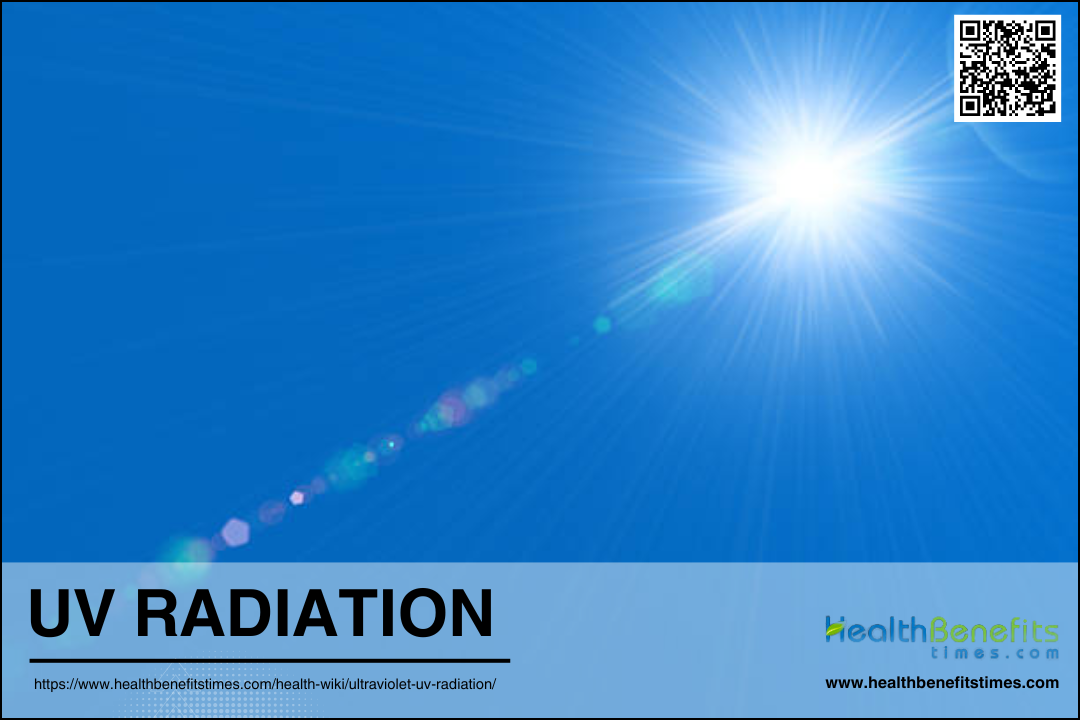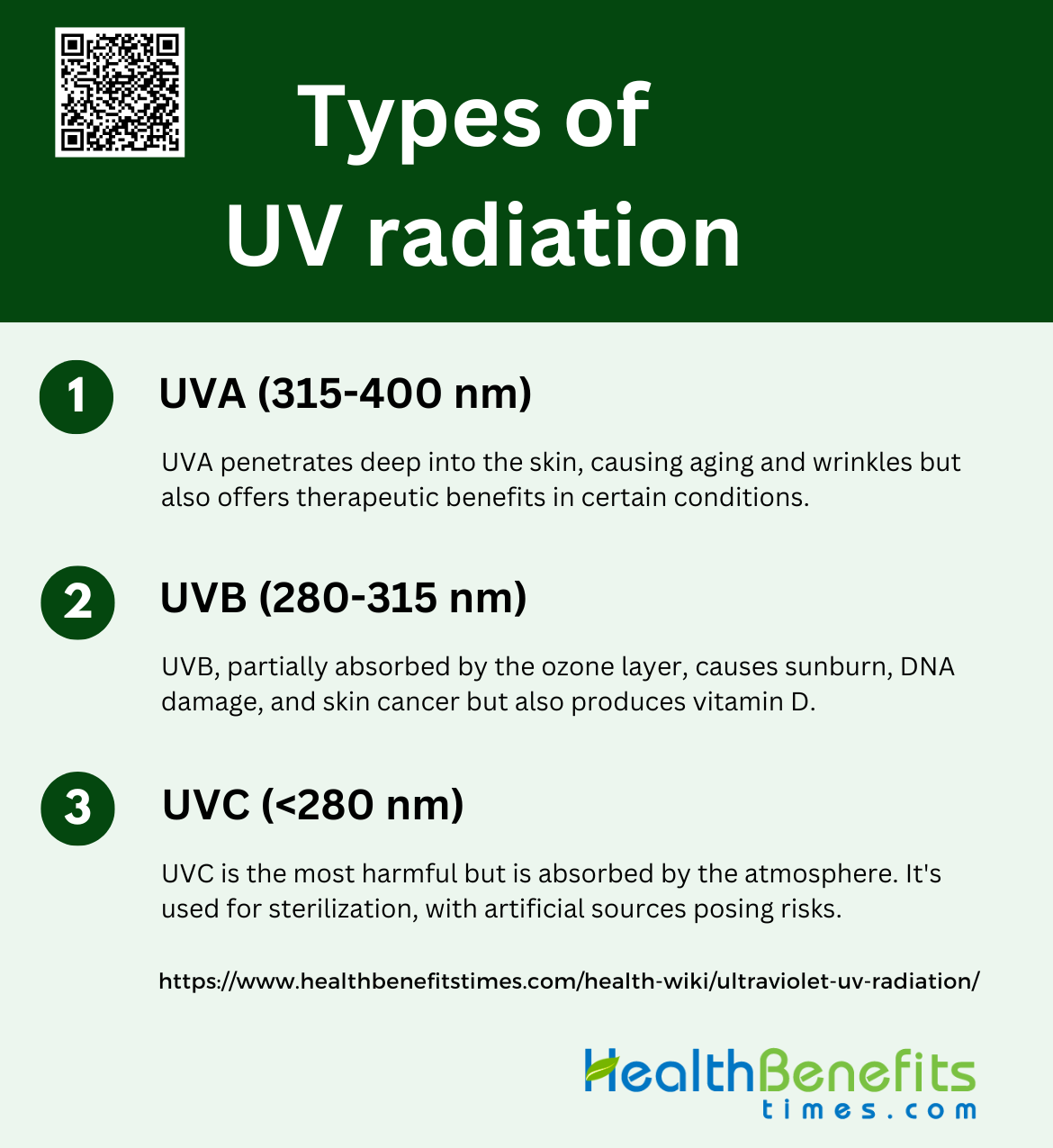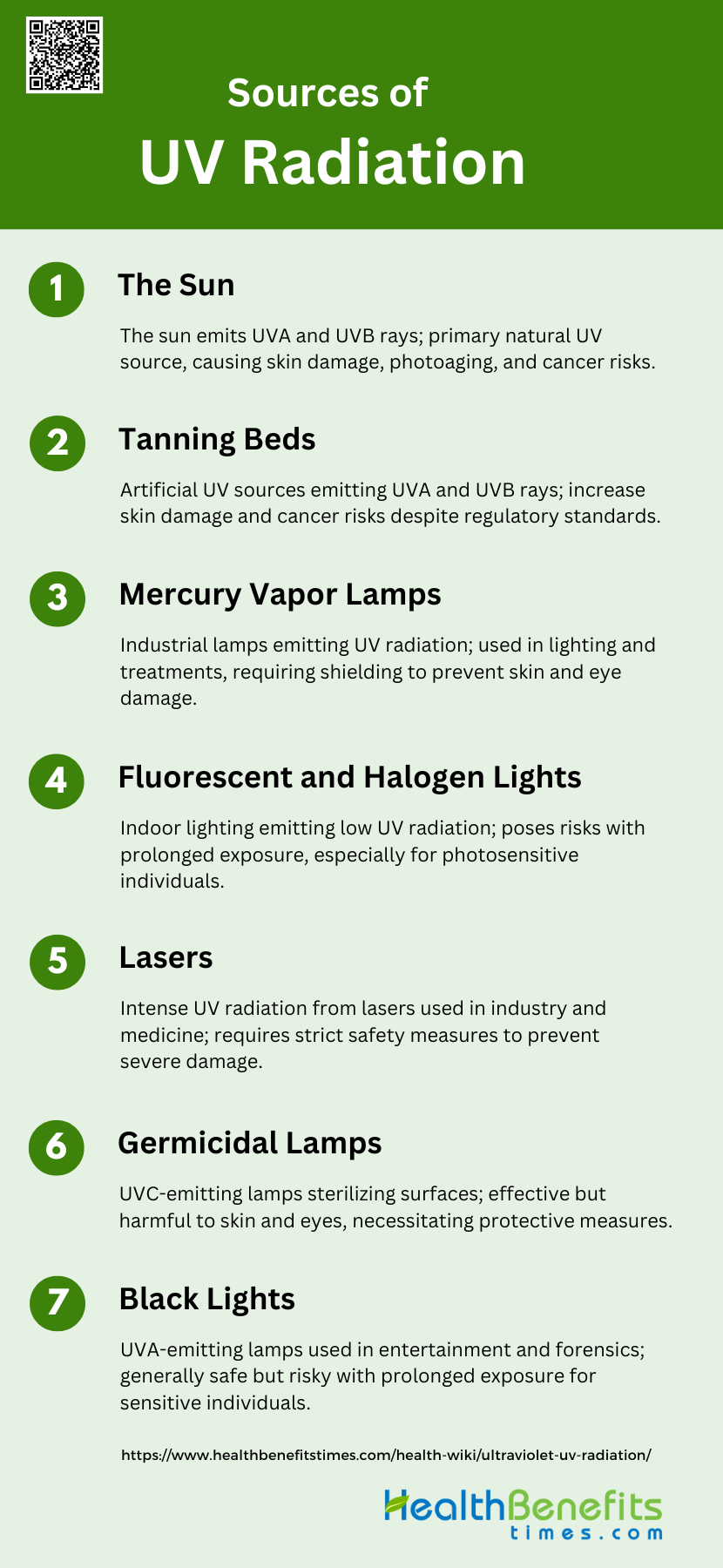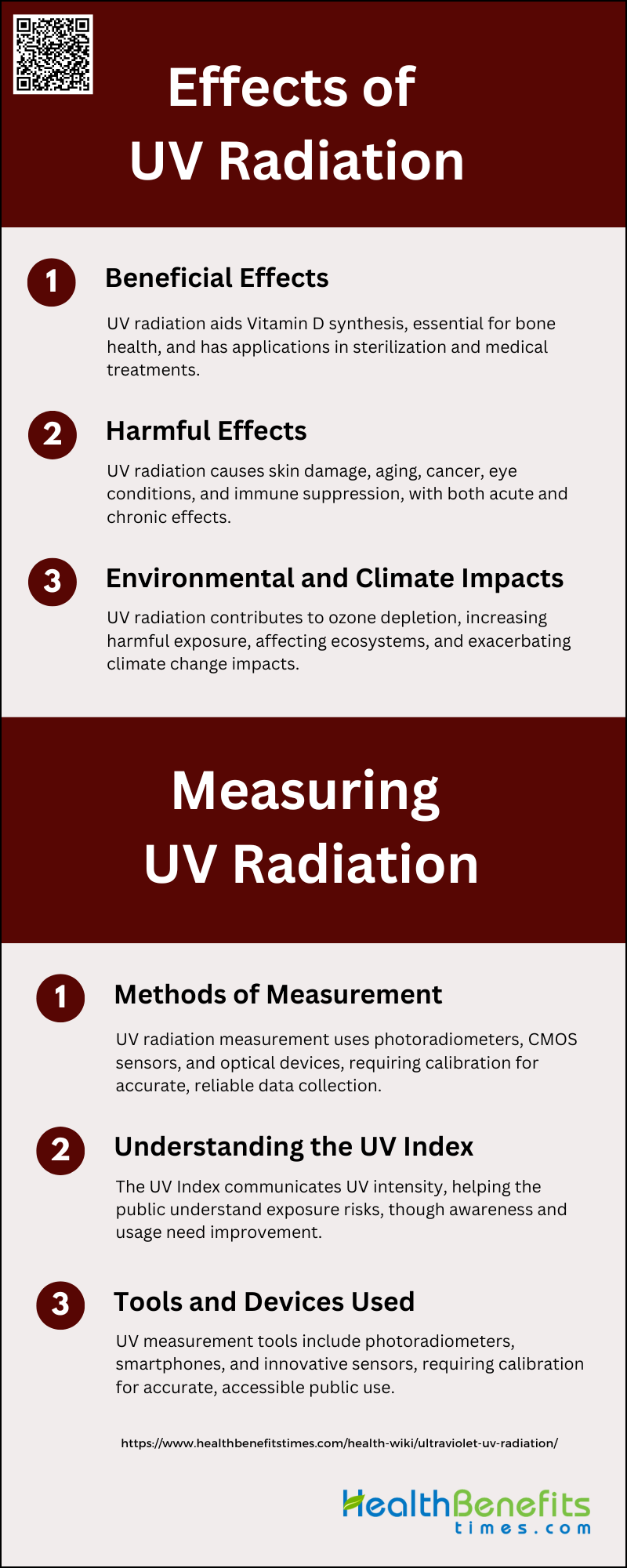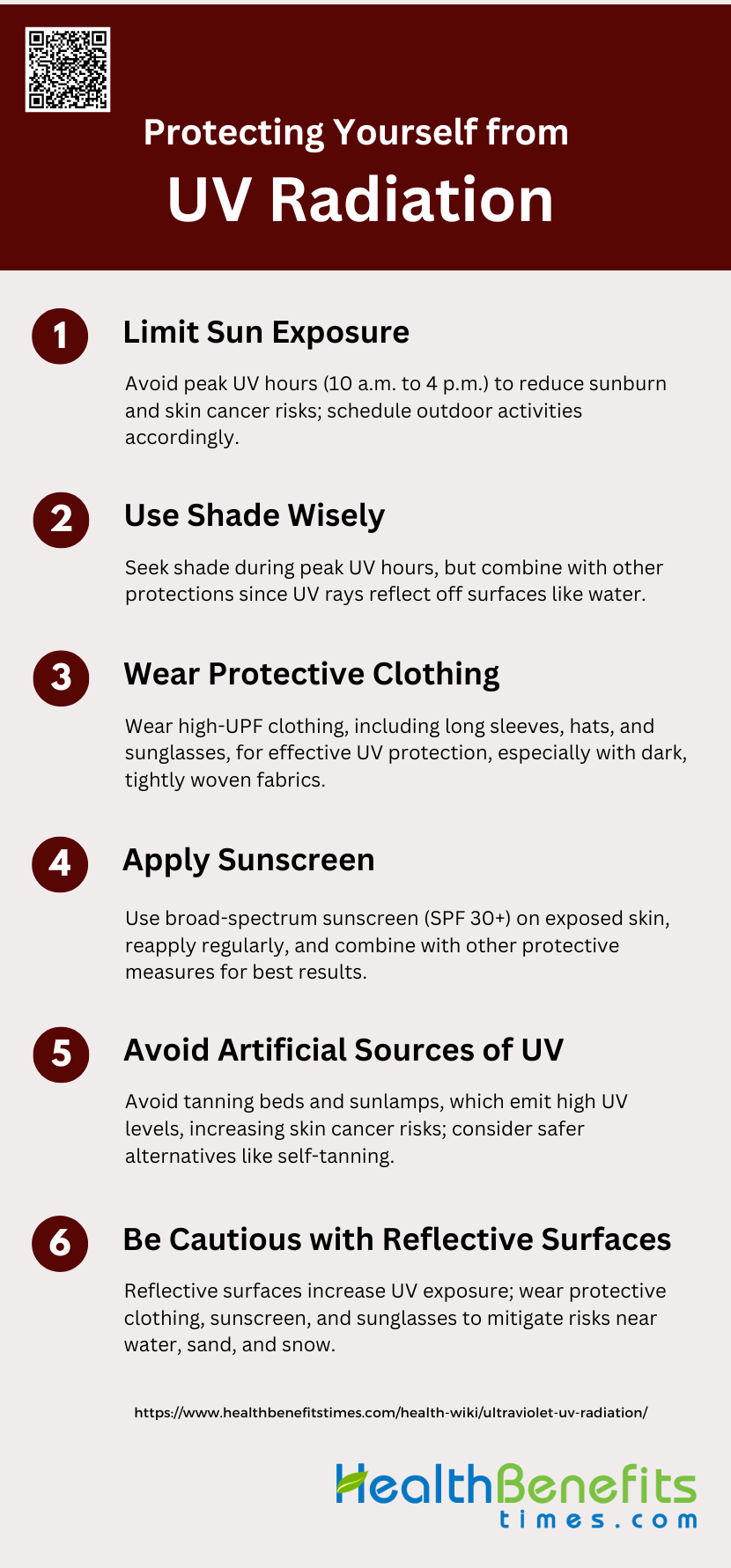Ultraviolet (UV) radiation is a form of electromagnetic radiation that comes from the sun and artificial sources like tanning beds. It is divided into three types based on wavelength: UV-A, UV-B, and UV-C. UV-A has the longest wavelength and is associated with skin aging, while UV-B has a shorter wavelength and is responsible for sunburns and playing a significant role in the development of skin cancer. UV-C has the shortest wavelength and is mostly absorbed by the Earth’s atmosphere, but it is used in various sterilization processes due to its germicidal properties. While UV radiation is essential for the production of vitamin D in the skin, overexposure can lead to harmful effects such as skin cancer and eye damage.
Types of UV radiation
Ultraviolet (UV) radiation, a component of sunlight, is categorized into three distinct types based on their wavelengths and effects on human health. Understanding these types is crucial as they each have different implications for skin health and environmental impact. Here’s a closer look at the three types of UV radiation:
1. UVA (315-400 nm)
UVA radiation, with wavelengths ranging from 315 to 400 nm, is the longest wavelength and least energetic form of UV radiation. It constitutes a significant portion of the UV radiation that reaches the Earth’s surface, as it is not absorbed by the ozone layer. UVA can penetrate deep into the skin, reaching the dermis, and is known to contribute to skin aging and the formation of wrinkles. Interestingly, UVA has been found to have therapeutic effects in certain medical conditions, such as systemic lupus erythematosus (SLE), where long-wavelength UVA1 (340-400 nm) has shown to reduce disease activity and symptoms.
2. UVB (280-315 nm)
UVB radiation, with wavelengths between 280 and 315 nm, is partially absorbed by the ozone layer, allowing only a small fraction to reach the Earth’s surface. Despite its lower presence, UVB is highly biologically active and is responsible for causing sunburn, DNA damage, and contributing to skin cancer. UVB radiation can penetrate the epidermis and is known to induce the production of vitamin D in the skin, which is essential for bone health. However, its harmful effects, such as increased risk of skin cancer and photoaging, make it a significant concern for public health.
3. UVC (<280 nm)
UVC radiation, with wavelengths shorter than 280 nm, is the most energetic and potentially harmful type of UV radiation. Fortunately, UVC is almost entirely absorbed by the Earth’s atmosphere, particularly by the ozone layer, and does not reach the surface. Due to its high energy, UVC is used in various applications such as sterilization and disinfection, as it can effectively kill bacteria and viruses. Artificial sources of UVC are employed in medical and industrial settings to ensure sterile environments. Despite its beneficial uses, direct exposure to UVC can cause severe damage to living tissues.
Sources of UV Radiation
Ultraviolet (UV) radiation is a form of electromagnetic energy that comes from various natural and artificial sources. Understanding these sources is crucial for managing exposure and protecting skin health. Here are some of the primary sources of UV radiation:
1. The Sun
The sun is the primary natural source of ultraviolet (UV) radiation, emitting UVA, UVB, and UVC rays. However, UVC rays are mostly absorbed by the Earth’s atmosphere and do not reach the surface. Solar UV radiation can cause various skin conditions, including sunburn, tanning, and long-term effects such as photoaging and skin cancer. The intensity of UV radiation from the sun varies based on geographical location, time of year, and time of day. Protective measures, such as sunscreen and clothing, are essential to mitigate the harmful effects of solar UV radiation.
2. Tanning Beds
Tanning beds and sunbeds are artificial sources of UV radiation, primarily emitting UVA and UVB rays to induce tanning. These devices have become popular for achieving a year-round tan, especially in regions with less sunlight. However, the use of tanning beds is associated with an increased risk of skin damage and skin cancer, including melanoma. Regulatory standards have been established to control the emission levels of these devices, but public education on the risks associated with their use remains crucial.
3. Mercury Vapor Lamps
Mercury vapor lamps are commonly used in industrial and commercial settings, emitting UV radiation through the excitation of mercury vapor. These lamps are used in applications such as street lighting, photography, and medical treatments. While they are effective in their intended uses, exposure to UV radiation from mercury vapor lamps can cause skin and eye damage. Protective measures, such as shielding and limiting exposure time, are necessary to prevent harmful effects.
4. Fluorescent and Halogen Lights
Fluorescent and halogen lights are widely used for indoor lighting and can emit small amounts of UV radiation. While the UV output from these lights is generally low, prolonged exposure can still pose risks, particularly for photosensitive individuals. Fluorescent lamps are also used in various applications, including insect traps and phototherapy. It is important to use these lights with appropriate shielding and to follow safety guidelines to minimize UV exposure.
5. Lasers
Lasers are highly focused sources of light that can emit UV radiation, used in various industrial, medical, and research applications. UV lasers are employed in processes such as photolithography, medical treatments, and scientific experiments. Due to their high intensity, UV lasers can cause significant damage to skin and eyes if proper safety measures are not followed. Protective eyewear and controlled environments are essential to ensure safe use of UV lasers.
6. Germicidal Lamps
Germicidal lamps emit UVC radiation, which is highly effective in killing bacteria, viruses, and other microorganisms. These lamps are used in settings such as hospitals, laboratories, and food preparation areas to sterilize surfaces and air. However, UVC radiation is also harmful to human skin and eyes, causing erythema and potential carcinogenic effects. Protective measures, such as wearing protective gear and limiting exposure, are necessary to prevent adverse health effects.
7. Black Lights
Black lights are a type of fluorescent lamp that emits long-wave UVA radiation, commonly used in entertainment, art, and forensic applications. While black lights are generally considered safe for short-term exposure, prolonged exposure can still pose risks, particularly for photosensitive individuals. It is important to use black lights with caution and to follow safety guidelines to minimize potential health risks.
Effects of UV Radiation
Ultraviolet (UV) radiation has a wide range of effects on both human health and the environment. While it offers some beneficial applications, such as Vitamin D synthesis and medical uses, it also poses significant risks. Here are the various effects of UV radiation:
1. Beneficial Effects
UV radiation plays a crucial role in the synthesis of Vitamin D in the skin, which is essential for maintaining bone health and supporting the immune system. This process, known as vitamin D photosynthesis, is particularly important for populations at risk of vitamin D deficiency, such as the elderly. Additionally, UV radiation has applications in sterilization and medical treatments. For instance, UVB and UVA radiation are used in combination with chemical drugs to treat skin conditions like psoriasis and vitiligo, despite the associated risks. Moreover, UV radiation is employed in sterilization processes to eliminate harmful microorganisms, thereby preventing infections.
2. Harmful Effects
Exposure to UV radiation can cause significant skin damage, including sunburn, premature aging, and an increased risk of skin cancer. UV radiation is classified as a “complete carcinogen” due to its mutagenic properties and its role as both a tumor initiator and promoter. Acute effects on the skin include inflammation, tanning, and immunosuppression, primarily caused by UVB radiation. Chronic exposure leads to photoaging and photocarcinogenesis, which involves DNA damage and immune system modulation, ultimately resulting in skin cancers such as basal cell carcinoma, squamous cell carcinoma, and malignant melanoma. UV radiation also poses risks to the eyes, causing conditions like photokeratitis, and can suppress the immune system, reducing its ability to control skin cancer and infections.
3. Environmental and Climate Impacts
UV radiation has significant environmental and climate impacts, particularly through its role in ozone layer depletion. The ozone layer acts as a protective shield, absorbing the majority of the sun’s harmful UV radiation. Depletion of the ozone layer leads to increased UV radiation reaching the Earth’s surface, which can have detrimental effects on both human health and ecosystems. Additionally, UV radiation contributes to climate change by affecting atmospheric chemistry and influencing the balance of greenhouse gases. The increased UV exposure due to ozone depletion can exacerbate the effects of climate change, leading to more severe environmental consequences.
Measuring UV Radiation
Understanding the intensity and impact of ultraviolet (UV) radiation is essential for both health and environmental monitoring. Various methods and instruments are used to measure UV radiation levels accurately. Here are some key techniques for measuring UV radiation:
1. Methods of Measurement
Measuring UV radiation involves various techniques and instruments to ensure accurate and reliable data. One common method is using photoradiometers equipped with UV erythemal irradiance probes, which measure the intensity of UV radiation across a specific wavelength range. Another approach involves the use of CMOS sensors in smartphone cameras, which are sensitive to UV radiation and can be optimized using fog computing to enhance accuracy. Additionally, specialized optical measurement devices are employed to calculate erythemally weighted UVB (EUVB) by applying specific functions to the intensity values in different wavelengths. Calibration methods, such as one-step and two-step techniques, are also crucial for ensuring the accuracy of UV radiometers.
2. Understanding the UV Index
The UV Index (UVI) is a standardized measure used to communicate the intensity of UV radiation to the public, helping to raise awareness about the potential harmful effects of UV exposure. It is derived from the output signal of UV radiometers and is influenced by calibration methods, which can significantly affect the accuracy of the reported UVI values. The UVI is essential for informing the public about the risk levels of UV exposure, with higher values indicating greater potential for skin damage. Despite its importance, public comprehension and use of the UVI for sun safety behaviors remain low, highlighting the need for better educational interventions.
3. Tools and Devices Used
Various tools and devices are used to measure UV radiation, ranging from high-precision scientific instruments to consumer-grade products. Portable photoradiometers and spectroradiometers are commonly used in research settings for their accuracy. Smartphones equipped with CMOS sensors and specialized apps can also measure UV radiation, offering a more accessible option for the general public. Additionally, innovative devices like UVI sensor-based portable measurement tools and natural pigment sensors using turmeric have been developed to provide cost-effective and user-friendly alternatives for UV measurement. Calibration and characterization of these devices are essential to ensure reliable data.
Protecting Yourself from UV Radiation
Shielding yourself from ultraviolet (UV) radiation is crucial for maintaining skin and eye health. Implementing effective protection strategies can significantly reduce the risks associated with UV exposure. Here are some essential methods to protect your-self from UV radiation:
1. Limit Sun Exposure
Limiting sun exposure is a fundamental strategy to protect oneself from harmful ultraviolet (UV) radiation. The peak hours of UV radiation, typically between 10 a.m. and 4 p.m., should be avoided whenever possible to reduce the risk of skin damage and skin cancer. During these hours, the intensity of UV radiation is at its highest, increasing the likelihood of sunburn and long-term skin damage. Studies have shown that reducing time spent in direct sunlight can significantly lower the risk of developing skin cancer and other UV-induced skin conditions. Therefore, planning outdoor activities for early morning or late afternoon can be an effective measure to minimize UV exposure.
2. Use Shade Wisely
Using shade wisely is another effective method to protect against UV radiation. Seeking shade, especially during peak UV hours, can significantly reduce exposure to harmful rays. Natural shade from trees or man-made structures like umbrellas and canopies can provide substantial protection. However, it is important to note that shade alone may not offer complete protection, as UV rays can reflect off surfaces such as water, sand, and concrete, reaching the skin indirectly. Combining shade with other protective measures, such as wearing protective clothing and applying sunscreen, enhances overall protection against UV radiation.
3. Wear Protective Clothing
Wearing protective clothing is a highly effective way to shield the skin from UV radiation. Clothing designed with a high Ultraviolet Protection Factor (UPF) can block a significant amount of UV rays, providing better protection than sunscreen alone. Items such as long-sleeved shirts, pants, wide-brimmed hats, and sunglasses are recommended for comprehensive coverage. The effectiveness of protective clothing depends on the fabric’s weave, color, and UPF rating, with tightly woven, dark-colored fabrics offering the best protection. Regular clothing can also provide substantial protection, with most summer clothing offering UPF values comparable to high-SPF sunscreens.
4. Apply Sunscreen
Applying sunscreen is a crucial step in protecting the skin from UV radiation. Broad-spectrum sunscreens with a Sun Protection Factor (SPF) of 30 or higher are recommended to guard against both UVA and UVB rays. Sunscreen should be applied generously and evenly to all exposed skin areas, and reapplication is necessary every two hours or after swimming, sweating, or towel drying. Despite its importance, sunscreen alone is not sufficient for complete protection and should be used in conjunction with other protective measures such as clothing and shade. Proper education on the correct use and selection of sunscreen is essential for effective photoprotection.
5. Avoid Artificial Sources of UV
Avoiding artificial sources of UV radiation, such as tanning beds and sunlamps, is critical for reducing the risk of skin cancer and other UV-related skin damage. These artificial sources can emit UV radiation levels much higher than natural sunlight, significantly increasing the risk of skin damage and cancer. Tanning beds, in particular, have been linked to an increased incidence of melanoma and other skin cancers, especially among young people. Public health campaigns and education efforts emphasize the dangers of artificial UV exposure and encourage the use of safer alternatives, such as self-tanning products, to achieve a tanned appearance without the associated risks.
6. Be Cautious with Reflective Surfaces
Reflective surfaces such as water, sand, snow, and concrete can amplify UV exposure by reflecting and scattering UV rays, increasing the risk of sunburn and skin damage even in shaded areas. It is important to be aware of these surfaces and take additional protective measures when near them. Wearing protective clothing, applying broad-spectrum sunscreen, and using UV-blocking sunglasses can help mitigate the increased exposure from reflective surfaces. Understanding the impact of reflective surfaces on UV exposure is essential for comprehensive sun protection, particularly in environments where these surfaces are prevalent.


